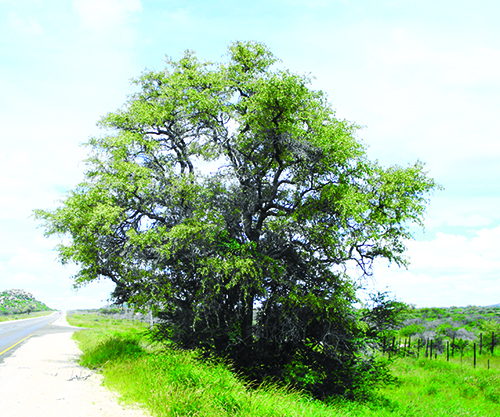THE Leadwood Tree can always be identified by its deeply lengthwise fissured, pale grey bark, which splits into narrow rectangular pieces.
While it is the tallest of all the Combretum species in Namibia it has the smallest four-winged fruit so typical of this genus. The fruits are characteristically yellow, densely covered in small scales, and measure about 10 – 20 x 15 mm. Very numerous, they give the entire tree a yellowish appearance for much of the year.
Names: G. Ahnenbaum; A. Hardekool; Her: Omumborongbonga; Nd Ky: omukuku
The leadwood tree occurs from central Namibia northwards, typically along the banks of dry river courses but also on plains and hill slopes. The photo above was taken at the turn-off of the D2515 from the B1, about 7 k south of Otjiwarongo.
Mostly the leadwood is a single-stemmed tree 7 to 15 m high with a very characteristic, gnarled trunk. In north-western Namibia it also occurs as a shrub so different from the mature tree that it has a separate local name.
The narrowly elliptic leaves (30 – 80 x 9 – 40 mm) grow opposite, successive pairs set at right angels to each other. They are simple, grey-green, and their margins are often wavy.
Young saplings and new shoots on mature trees branch at right angels and have spiny lateral shoots, while the rest of the tree has no thorns at all.
The sweetly scented but rather inconspicuous yellowish flowers grow in spikes mostly from November until March. At 1180 kg/m3 leadwood is the heaviest wood on earth, a fact referred to by the English common name. Before iron implements became available in Africa hoes were made of this timber. It produces excellent charcoal giving rise to the Afrikaans name “hardekool” i.e. ‘hard coal’.
It has been established by carbon dating that leadwood trees can reach an age of 1000 years and remain erect for another 50. According “Trees and Shrubs of Namibia” many of the finest specimens of leadwood in southern Africa are found in Namibia. This in addition to the mystical significance they hold for many Namibians and the fact that they are very slow growing necessitates special protection efforts to conserve these ancient giants. On no account should they be turned into charcoal for commercial gain as reportedly happens west and north-west of Outjo. Several invasive species such as the hook-thorn (A. mellifera), the sickle-bush (Dichrostachys cinerea) and Prosopis provide equally excellent charcoal – these are the species to use as fuel for cooking, camp fires and for making charcoal.
Many inhabitants of Namibia regard the leadwood tree as the ancestor of mankind as well as cattle and game. The German common name “Ahnenbaum” or ‘ancestor tree’ refers to this aspect. According to legend Nangombe and Kathu, ancestors of the Herero and the Ovambo people, came from the east. At the great Omumborongbonga tree in the Ondangwa area the two brothers separated, Kathu leading the Herero onwards in search of pastures while Nangombe and his followers settled on the fertile plains of central northern Namibia.
The leaves of the leadwood are browsed by livestock and game. Smoke from burning leaves is inhaled to treat colds and coughs. The leadwood tree is protected by forestry legislation.
Stay informed with The Namibian – your source for credible journalism. Get in-depth reporting and opinions for
only N$85 a month. Invest in journalism, invest in democracy –
Subscribe Now!






